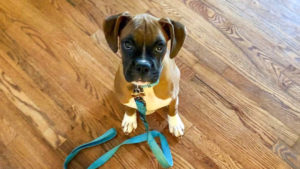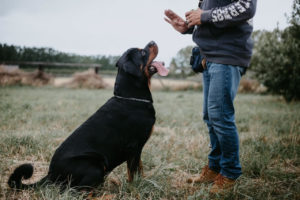If you’re new to dog training, you probably have what feels like an unending list of questions about the best training method, whether to work with a dog trainer or do it yourself, how to get started, which commands to teach first and more.
You might also be wondering what your dog thinks about all of it.
The good news: Whether you’ve recently welcomed a puppy to your pack or you’re just getting started with an older four-legged family member, most dogs enjoy the training process. This month we’ll talk about why, as well as tips for how to set – and maintain – a successful training routine.
Let’s get started.
Do dogs like to be trained?
Assuming the methods are motivational and fair, I’d say the majority of dogs enjoy training. Plus, training strengthens the bond between you and your dog. It’s a great way to connect while also providing your dog mental and physical stimulation.
When teaching new commands, it’s helpful to use things that motivate your dog. These can be both primary and secondary motivators. Primary motivators are things your dog needs to survive, and they typically produce a higher degree of motivation – food, for example. Secondary motivators are things your dog has learned to enjoy, such as praise, physical affection, toys and play.
Is it ever too late to start training a dog?
No! It’s never too late to start or continue training a dog.
Dogs are capable of learning new concepts throughout their lives. In fact, I receive dogs for training that are in their senior years, and they enjoy the training process just as much as the younger dogs. It can sometimes take more time to modify older dogs’ behavior, especially if they’ve been practicing those behaviors for a much longer time, but they’re plenty capable of making the adjustment. Dogs live in the moment, so to speak, and are quite adaptable.
What can (or can’t) dog training do?
Dog training can have a great impact on the life you live with your dog. It’s great for your dog’s mental and physical stimulation, creates a calmer, more obedient dog, and helps manage or stop unwanted or dangerous behaviors. Training should be a part of every dog’s life, as it results in a happier, more balanced dog.
Training can have its limitations, though. For dogs with neurological disorders, or those that are physically limited, training may not be as productive or beneficial. Although these cases are rare, there are some dogs that are genetically predisposed to certain behaviors, and may have a difficult time adjusting into society. Training could certainly help those dogs, but it may not be enough to overcome poor genetics.
How long should dog training sessions last?
That depends on the dog and its age, level of training and temperament. Puppies, for example, are obviously going to have shorter attention spans that adult dogs.
I typically recommend keeping training sessions on the shorter side. Pick an exercise or two and focus on that for a session. Then, you can build upon the previous session and begin to increase the level of difficulty or length of time. Dogs need time to develop mental and physical stamina. They can lose interest or motivation to work if they’re pushed too far too soon.
How often do I need to practice with my dog?
Here again, that depends on the dog and the level of training.
Consistency and repetition are vitally important in dog training. Dogs need hundreds of repetitions to become proficient in a command or task. Every dog learns at a different rate, so some dogs may pick up on commands or tasks much quicker than other dogs do.
When I work with dogs, I like to do several short sessions throughout the day. I also implement training into my lifestyle, and I recommend this to my clients as well. How you live with your dog directly affects their behavior both inside and outside your home.
For example, the “place” command (teaching your dog to stay and lie quietly on a dog bed until released), is something you can implement in daily life. Once the command is learned, it becomes passive training. This command requires your dog to work on impulse control and holding position, but it’s not something that requires active training for you.
I recommend doing some sort of active or passive training with your dog daily. A few ideas:
- Have your dog on “place”
- Practice “heel” on a walk
- Work on “sit” or “down” stays while on a walk or at home
- Have your dog wait politely for his or her meal
- Practice waiting patiently before entering and exiting doorways
All these protocols and exercises create a shift in dogs’ mindsets. We want our dogs to look to us for guidance. To do that, we need to implement training and create rules and boundaries, which, in turn, create happier, calmer and more respectful dogs.





